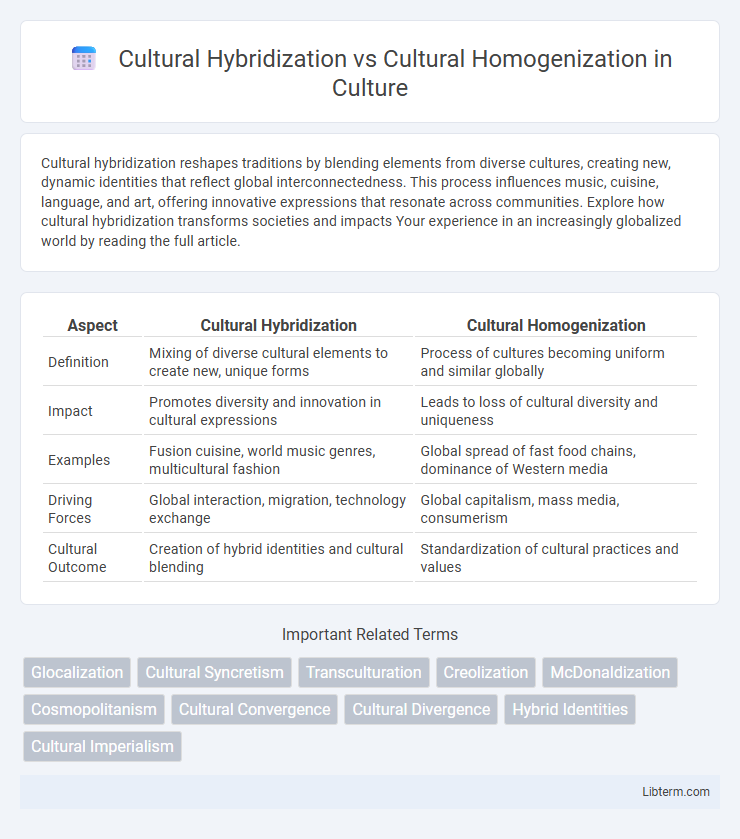Cultural hybridization reshapes traditions by blending elements from diverse cultures, creating new, dynamic identities that reflect global interconnectedness. This process influences music, cuisine, language, and art, offering innovative expressions that resonate across communities. Explore how cultural hybridization transforms societies and impacts Your experience in an increasingly globalized world by reading the full article.
Table of Comparison
| Aspect | Cultural Hybridization | Cultural Homogenization |
|---|---|---|
| Definition | Mixing of diverse cultural elements to create new, unique forms | Process of cultures becoming uniform and similar globally |
| Impact | Promotes diversity and innovation in cultural expressions | Leads to loss of cultural diversity and uniqueness |
| Examples | Fusion cuisine, world music genres, multicultural fashion | Global spread of fast food chains, dominance of Western media |
| Driving Forces | Global interaction, migration, technology exchange | Global capitalism, mass media, consumerism |
| Cultural Outcome | Creation of hybrid identities and cultural blending | Standardization of cultural practices and values |
Introduction to Cultural Hybridization and Homogenization
Cultural hybridization refers to the process where distinct cultural elements blend to create new, syncretic forms of culture, reflecting dynamic interactions and mutual influence among diverse societies. Cultural homogenization describes the trend toward uniformity in cultural expressions, often driven by globalization and the spread of dominant cultures, leading to the reduction of cultural diversity. Understanding these concepts is crucial for analyzing how globalization shapes cultural identities and societal transformations worldwide.
Defining Cultural Hybridization
Cultural hybridization refers to the process through which distinct cultural elements blend to create new, dynamic cultural forms that transcend original boundaries. This phenomenon manifests in various domains such as language, cuisine, music, and fashion, reflecting globalization's impact on local traditions. Unlike cultural homogenization, which leads to uniformity, cultural hybridization fosters diversity by enabling cross-cultural interactions and innovations.
Understanding Cultural Homogenization
Cultural homogenization refers to the process by which diverse cultural expressions and practices converge towards a uniform global culture, often driven by globalization, mass media, and multinational corporations. This phenomenon results in the diminishing distinctiveness of local traditions, languages, and customs, leading to a more standardized cultural landscape worldwide. Understanding cultural homogenization is crucial for recognizing the challenges it poses to cultural diversity and the preservation of unique cultural identities.
Historical Context of Cultural Exchange
Cultural hybridization emerged historically through trade routes like the Silk Road, where diverse cultures exchanged goods, ideas, and customs, resulting in blended traditions and innovations. In contrast, cultural homogenization intensified during colonialism and globalization, as dominant powers imposed uniform cultural standards, leading to the erosion of local practices and identities. The historical context of cultural exchange reveals a dynamic interplay between the preservation of distinct cultures and the creation of new, hybrid forms through continuous interaction.
Drivers of Cultural Hybridization
Globalization, technological advancements, and increased migration act as primary drivers of cultural hybridization by facilitating the exchange and blending of diverse cultural elements. Social media platforms enable rapid dissemination and fusion of cultural practices, languages, and identities across geographical boundaries. Economic integration and transnationalism also promote hybrid cultural expressions through continuous interaction between local traditions and global influences.
Factors Influencing Cultural Homogenization
Globalization-driven mass media, multinational corporations, and technological advancements are primary factors influencing cultural homogenization, promoting uniform cultural expressions worldwide. Urbanization and economic integration foster shared lifestyles and consumption patterns, diminishing local cultural distinctions. Government policies and education systems that emphasize dominant languages and cultural norms further accelerate the spread of homogenized cultural identities.
Case Studies: Hybridization in Global Cultures
Case studies of cultural hybridization reveal how global cultures blend local traditions with international influences, creating unique expressions such as K-pop's fusion of Korean and Western pop elements or the global spread of fusion cuisine combining diverse culinary practices. These hybrid forms challenge the dominance of cultural homogenization, where global brands and media often standardize cultural experiences worldwide. Studies on cultural hybridization demonstrate adaptive strategies in maintaining cultural identity while embracing globalization's interconnectedness.
Media and Technology: Agents of Homogenization
Media and technology have accelerated cultural homogenization by spreading dominant global narratives and standardized content across diverse societies, often prioritizing Western perspectives. Platforms like social media, streaming services, and digital news outlets promote uniform cultural consumption patterns, diminishing local traditions and languages. This digital convergence reduces cultural diversity by aligning global audiences with similar values, aesthetics, and lifestyles driven by multinational tech corporations.
Impacts on Identity and Community
Cultural hybridization fosters diverse identities by blending traditions, languages, and customs, enriching communities with multifaceted cultural expressions. In contrast, cultural homogenization often leads to the erosion of unique cultural traits, diminishing local identities and undermining communal cohesion. These dynamics impact social belonging and collective memory, influencing how communities perceive themselves and interact within globalized contexts.
Future Trends and Global Implications
Cultural hybridization is expected to intensify with advancing digital technologies and increased global connectivity, fostering diverse cultural expressions and innovation. In contrast, cultural homogenization continues to pose challenges by promoting dominant cultural norms and reducing local cultural distinctiveness. Future global implications include balancing cultural diversity with integration, influencing international policy, global marketing strategies, and cross-cultural communication frameworks.
Cultural Hybridization Infographic

 libterm.com
libterm.com